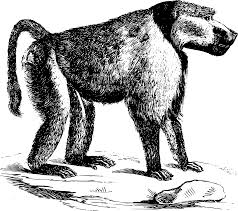Lives in the wild #4: Baboon
Hello everyone, it's time to visit the wilds again. Last episode of Lives in the wild, we got to be familiar with the Abyssinian and the journey into that part of the wilds was fun.
Today on lives in the wild, I am going to talk about the Baboon. But before I proceed, I will like to welcome you all to Lives in the wild.

Today's topic on Lives in the wild, I will share with you all a brief knowledge about the Baboon.
Let the journey begin
Baboon
Classification:
The Baboons are divided into different species. These species are;
Papio Anubis which is known as Olive Baboon
Papio Cynocephalus which is known as yellow Baboon
Papio Ursinus which is the Chacma Baboon
Papio Hamadryas which is the Hamadryas Baboon and
Papio Papio which is also known as Guinea Baboon.
Physical characteristics:
These kind of monkeys are strong, powerful and large in terms of size. The male Baboon is usually twice as big as the female Baboon. Though, the Baboon sizes varies according to their species and the Chacma Baboon is the largest of all The Baboon have large heads with long tails, their muzzle is like that of dogs but with cheek-pouches for storing food. The Baboon have fearsome canine teeth for defense against threats. The Baboon have aggressive-looking fur over the shoulders with a long mane and a distinctive bend at the base side of their tail.
Distribution and habitat:
Baboons are known to be widely spread throughout Africa, either on scrubs, rocky deserts, rainforests, and savanna. But presently, Baboons are only found majorly in different areas in Africa like the Southern part of Africa, North-east Africa, and West Africa.

image source
Reproduction:
Reproduction in the Baboonworld is a little bit similar to that of humans. Though, there are some distinctive features that are very different from that of humans.Whenever the female Baboons are ready to mate, they signify the males with a swollen bottom that turns red. This swollen red bottom notifies the males about mating. Gestation for Babbons is around six months and they only give birth to one offspring at a time and max of two.
The babies are referred to as infants. The infants feed on their mother's milk and hung around with their mother until 3 or 4 months. Unlike humans, Baboons can reproduce even when they are old.
Baboons are omnivorous which means that they feed on both plants and animals. Though their feast on animals isn't that kind of deep one. They feed on rodents, lizards, insects, eggs and some other smaller animals.
Do you know?
- Do you know Baboons can talk?
- Do you know that Baboons are closely related to humans?


